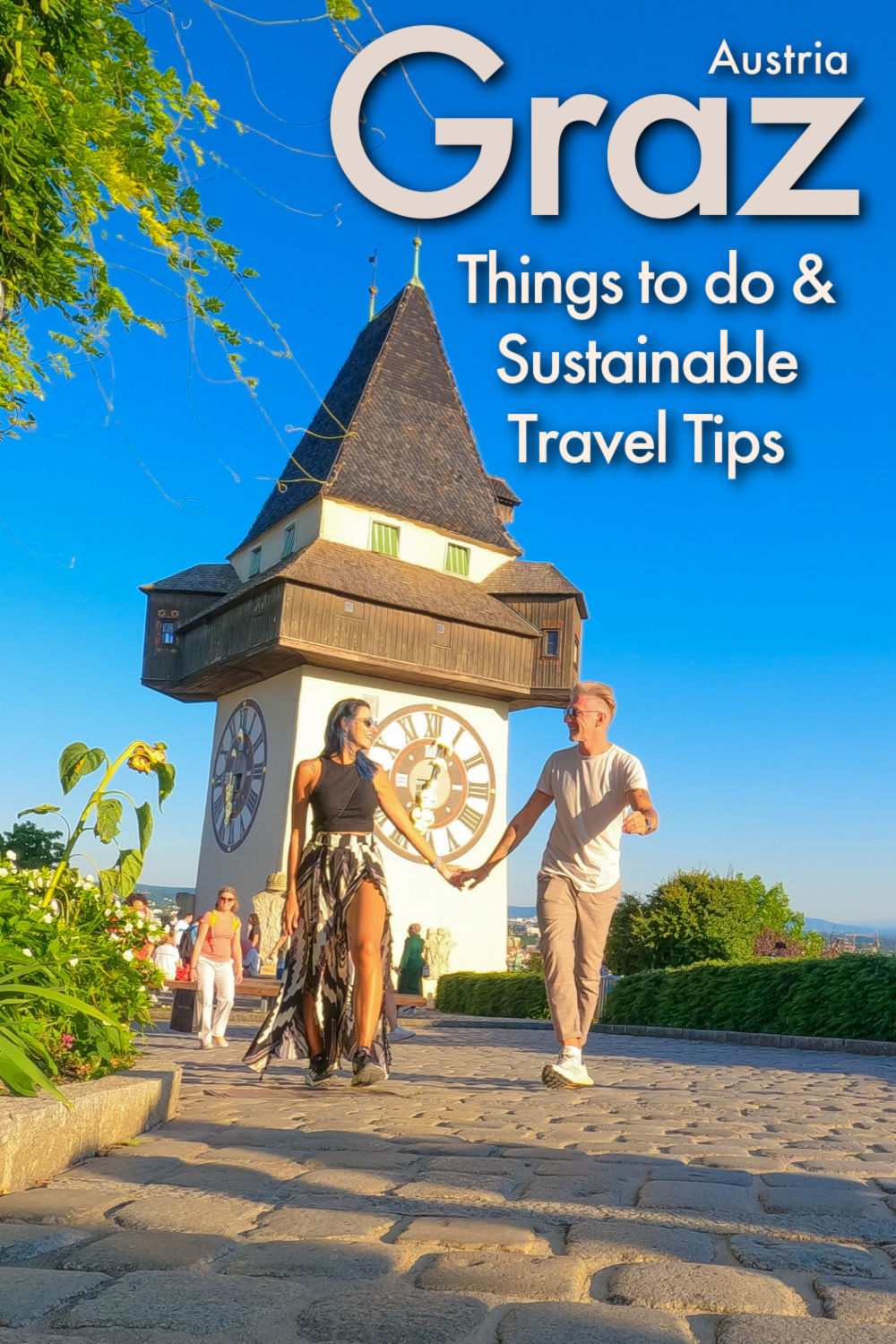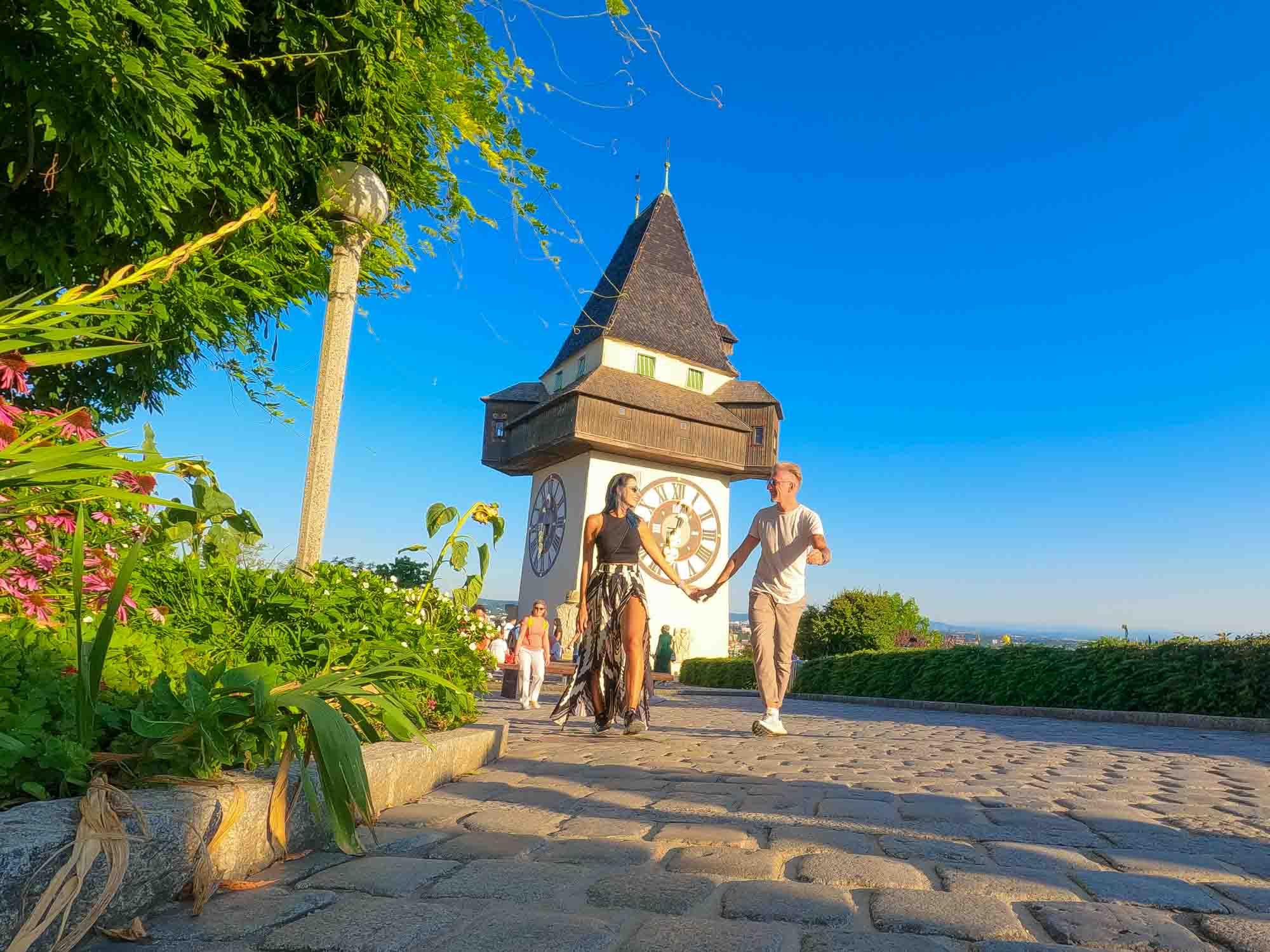Some of our links are affiliated, we will earn a commission when you buy a service or product. This will have no extra cost for you. For further info please refer to our Privacy Policy
Who would have thought an espresso tonic would be the perfect drink for a summer afternoon in Graz? Here I am, sipping this strong, refreshing coffee while admiring the charm of an old friend.
It’s our second trip to Graz, Austria, and now I can easily say that the city has stolen my heart and made me a more responsible and conscious traveler.

One more sip and another glance at the peculiar Mediterranean architecture that distinguishes Graz from other Austrian cities.
Suddenly. I heard Rob’s voice, “Ohh, this chocolate cake is divine.”
I’m not sure for how long I was lost in my thoughts about things to do in Graz, sustainable travel and all that happened in the last three days here. But one thing I know for sure, Eva’s homemade cakes are to die for, and they pair perfectly with an espresso tonic.
Another reflection from this afternoon’s break was ‘support small locals.’
I saw this message written in front of Eva’s CoffeeRide shop and it’s one example of Graz’s unique approach to sustainability.
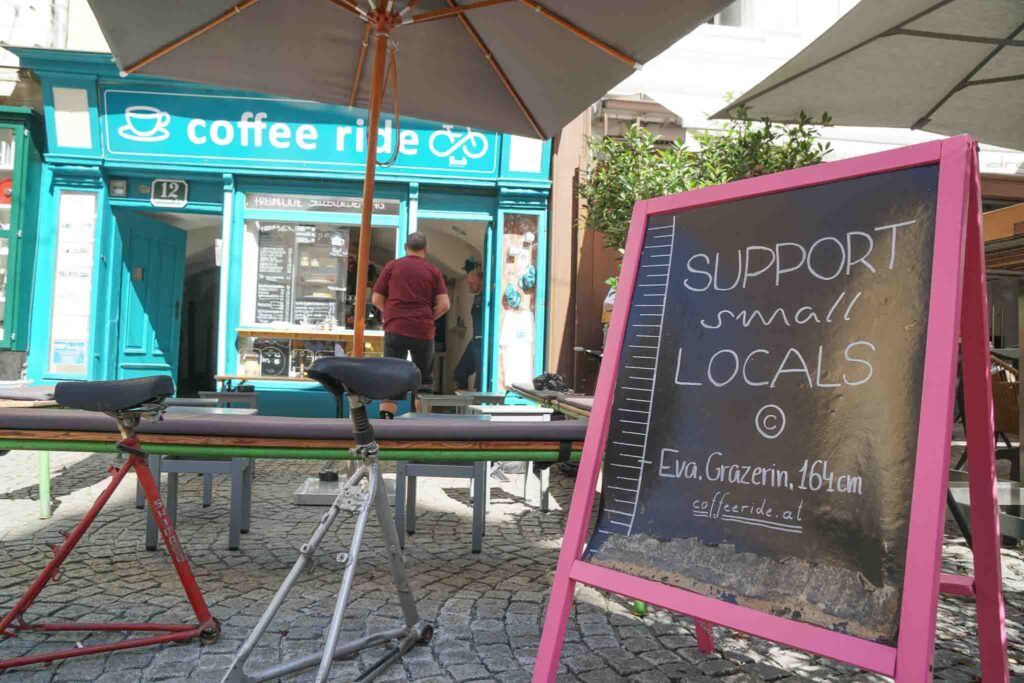
I dare say that sustainability is in the city’s way of life, built into the community, and travelers like us have the opportunity to learn about it and embrace it, just as Graz embraces us.
You are probably asking yourself, where we are going with all this cake, coffee and conscious traveling talk? Is this a guide to Graz or what?
Fair enough! Let’s organize things here.
Are you planning a trip to Graz or are searching for a new destination in Europe? Then this article is for you.
If you want to travel in a more responsible way, or are searching for sustainable travel destinations, this guide is also for you.
Becoming a conscious traveler in Graz
Before we get to sustainable things to do in Graz, let me share an important thought.
What is sustainable tourism?
“Tourism that takes full account of its current and future economic, social and environmental impacts, addressing the needs of visitors, the industry, the environment and host communities.”
– World Tourism Organization (UNWTO)
Put simply, sustainable travel should minimize the negative impacts of tourism and be beneficial to the destination, the community and the environment.
It’s like buying a coffee that comes from a fairtrade source that was roasted artisanally and locally, served with a homemade cake baked with local ingredients in a shop that values community and inspires you to cycle more. Eva, thank you for this experience.
How can you find this type of place and story instead of going to a fast food chain to grab an industrialized sweet?
Well, here is where being a responsible traveler comes into play, and how you research and plan your trip will make a positive impact on your experience and the place you visit.
The destination also plays a big role. If sustainability is part of the city’s values, this coffee experience will be available for the locals and tourists.
It’s here that Graz becomes the star of the show.
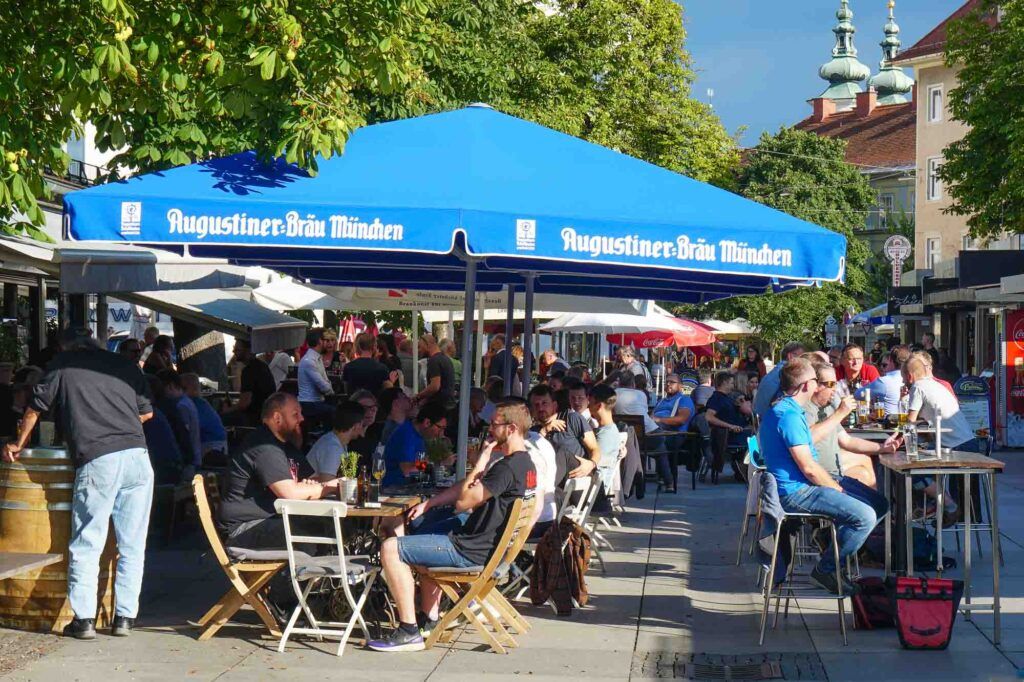
Sustainable Things to do in Graz
I was at Kunsthaus, aka the friendly alien and a must-see in Graz, when Rob called me.
“Are you done there? Come here to the shop with the beautiful lamps we saw yesterday. You need to meet the lady here.”
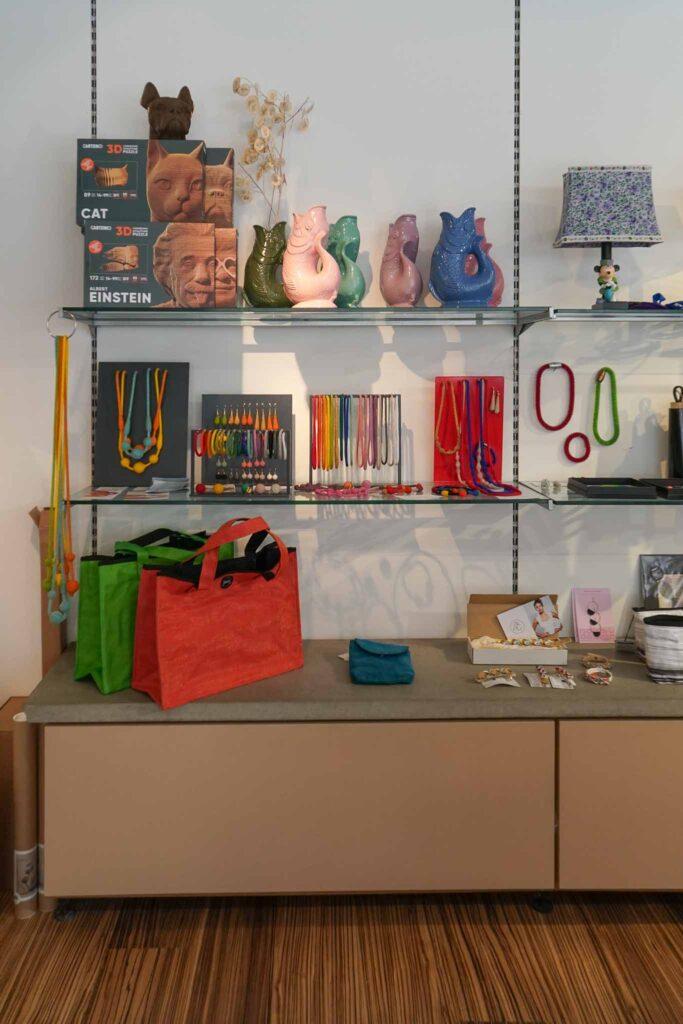
We spent 30 minutes, maybe an hour here. It was enough to understand that this trip would be about experiences and people, seeing the city through a conscious perspective and learning to be a better traveler.
Graz has many things to do, see, and places to visit, and if it’s your first time visiting the city, I recommend reading this Ultimate Guide to Things to do in Graz. It’s a comprehensive guide that I wrote after my first trip to Graz when I walked those streets from morning to evening, admiring, eating, drinking and enjoying Graz’s culture and history.
Now, this sustainable travel guide to Graz has a different focus. It’s about going beyond Graz’s tourist attractions. Think of it as an extra chapter of the official guide, the one that is essential to understanding the whole story, but published later.
So here is our list of sustainable things to do in Graz that can be easily combined with all city attractions.
Get out of Graz’s Old Town
Once you have been enchanted by the beautiful architecture in the old town, walked through peaceful courtyards and sipped your coffee (or wine) while admiring the Tower Clock, get yourself out of there.
The car-free streets with the pastel-colored building are UNESCO Heritage Sites and they tend to get all the attention. However, there is more to Graz on the other side of the river, behind the Stadtpark.
Going to lesser-known places and supporting the local community are pillars of sustainable travel, and give you the opportunity for new experiences.

Taking about new experiences, we visited an unusual museum in Graz, a place dedicated to locks, keys and doors.
The Schell Collection houses more than 13,000 pieces from all over the world collected over 50 years. Hanns Schell is the person behind such passion, a Graz born mountaineer and collector who summited incredible mountains and put together a fascinating museum of everything that can be locked and unlocked.
The Lock and Key Museum is located in the Lend, one of many interesting places we discovered there.
We focused our trip on Lend and Gries (neighbourhoods on the other side of the Mur River), and I didn’t know I would love these areas so much.
Once not the best places to be, Lend and Gries are now where diversity mingles with art and real life, where music, food and children take over the squares, and modern buildings flirt with the past.
Lend was the red-light district of Graz, a place where outsiders lived and passed by. An important route between Trieste, Italy, and Vienna. A route that brought good and bad things to the area.
Years passed, the city changed and gentrification was unstoppable. I asked our guide: “Is this cleaning and modernizing movement changing a lot the character of the neighborhood?”
“When you have quality food, good and useful design in your daily life and art at your reach, people grow, things get better, Lend and Gries are getting better, but without losing their identity,” answered Claudia.
I nodded and we kept walking.
I liked what I saw in Lend and Gries. Graffiti and an art museum in the same area. Traditional food, kebab shops, bars, nightclubs, monasteries and churches all rubbing shoulders. People from different walks of life share the same space.
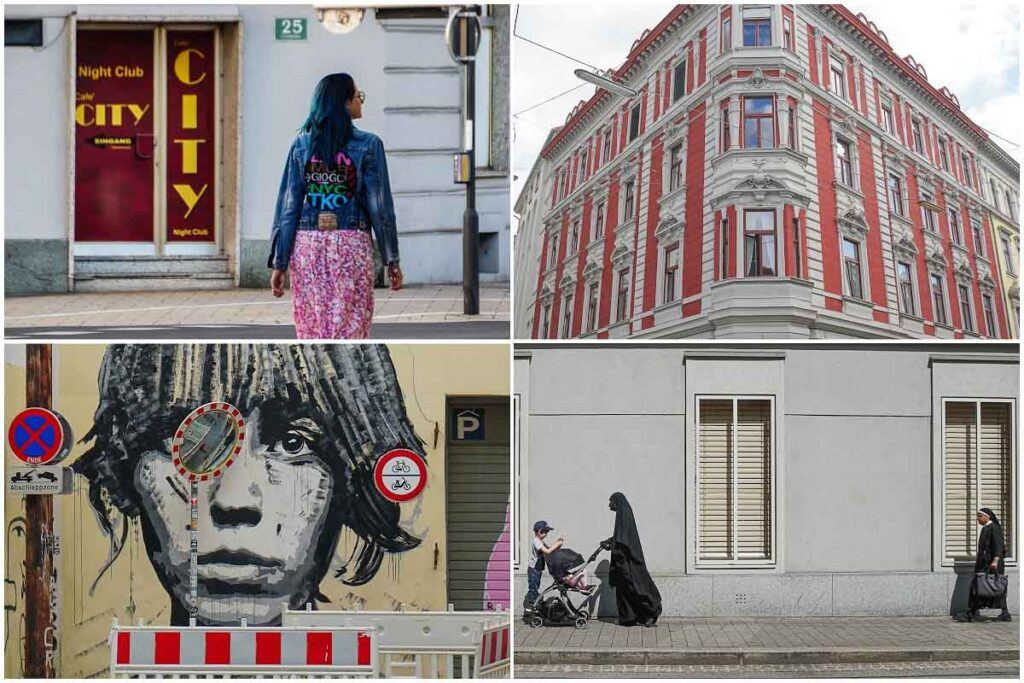
It was refreshing to see a side of Graz that is a bit less Baroque or Renaissance, less polished than the old town. It gave me a different perspective of the city.
My suggestion is to book a local guide (Claudia was amazing) who can give you glimpses of the past, present and future. So more than admiring a neighborhood that is becoming trendy, you get to understand it.
After the tour, you will have new knowledge and likely many questions that will lead you to new discoveries.
Talk to locals, they know the best of Graz
It was around 9:30 in the morning when we passed by this window shop. Our guide said hello to a woman who, like a busy bee, was carrying things in and out of her hive.
Maria greeted us and invited us to come back later when the shop was fully open and operating.
I answered yes, and said I would see her later!
Our guided tour followed a path and we didn’t come back to that shop on the same day. But I like to keep my promises, so we went to Managerie on a Saturday morning and it was better than I anticipated.
Managerie is a window shop that sells new and second-hand items, from furniture to decorations, clothes, accessories, hats and drinks.
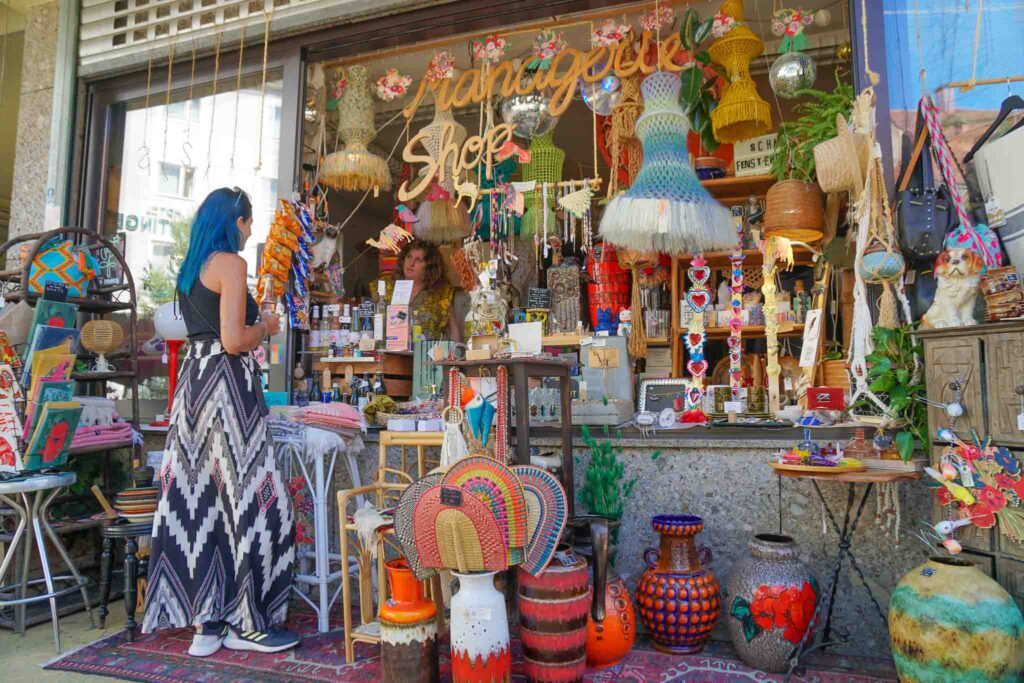
More than a shop, the Managerie kiosk is a place to meet people, talk and get to know the neighborhood.
Maria and I started talking about an item in the shop, then another client who was having a drink jumped in and soon Maria’s daughter, Resi Reiner (who is a singer, check her out), her dog, and another guy were involved in the conversation.
Maria told me about how the community in Lend gets together to plan festivals, discuss local issues and take care of each other. She gave us recommendations of where to go and what to do. She also told us to come back to Graz in May for Lendwirbel and Spring Festival.
I learned one more thing: in Graz, you never say no when someone offers you a rosé, even if it is 10 A.M. It was my first time trying Rost, a delicious, locally produced rose wine spritz, and I loved it. So don’t forget to try it.
Your morning fruits & snacks are around the corner
Before my morning spritz, I had a lovely breakfast. We stayed at a very interesting hotel in the Lend area (more about it later).
The breakfast served at LendHotel was sourced locally from the farmers’ market located at LendPlatz, the beating heart of the neighborhood. Everything was fresh, seasonal and delicious.

The market is not only a place where people and establishments get their fruits, veggies, cheese and flowers, it’s where life happens.
Graz has 14 farmers’ markets, the one in Lend and the Kaiser-Josef Market near the Graz Opera are open in the mornings from Monday to Saturday, making the farm-to-table movement a reality.
The markets connect producers with consumers, and the food you see there is probably what you will eat for lunch or dinner at one of Graz’s restaurants.
My tip is to look for the stalls selling strudel or fruit cakes. Grab some for your morning snack, before or after the rosé.
Go to church for a local experience
This has nothing to do with religion.
Well, it does, but what I mean is that you don’t need to be religious to visit Andreas Church. And I’m pretty sure that what you will see will intrigue you. At least I felt intrigued.
St. Adreas’s Catholic Church was a regular church for years. Then, in 1999, it became a hub for contemporary art, performances and music.
The first thing you will notice is the church’s exterior covered in random words written in different fonts and colors, and “science” is spelled there.
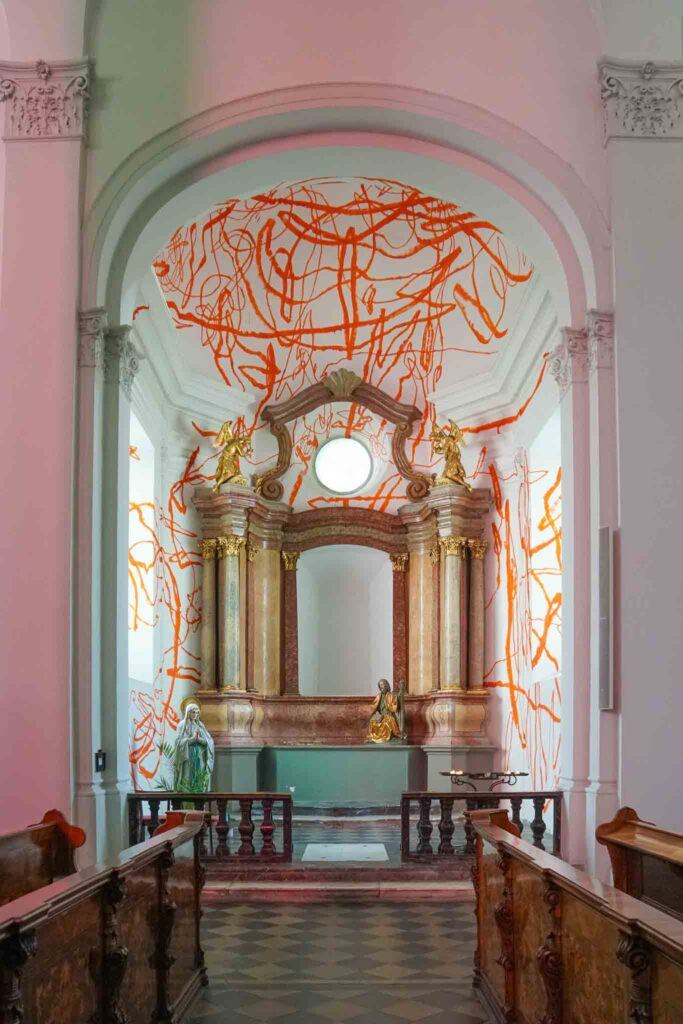
Once you are inside, things get even more unusual, like windows covered in not-so-traditional paintings, and the Dominican Chapel from 1717 decorated by an orange spatial drawing made by the Austrian painter Otto Zitko.
I particularly liked the column, the altar and Jesus covered in mirror fragments. And don’t forget to notice the swing hanging in the middle of the church. Is that to remind us of the ups and downs in life? Who knows?
The only thing for sure is that Andreas Church is a unique and interesting local attraction and a place of faith. You can join one of the services, they have mass in English and Spanish, and you can get together with Graz’s African and Latino communities.
Get hydrated in the right way
We visited Graz in August with long hot days. Climate change is real, Europe is having an insanely hot summer and hydration is a necessity. However, let’s do our share and avoid plastic water bottles as much as possible.
Always carry a reusable bottle with you. Graz has many water fountains across the city, so it’s easy to get fresh, clean water.
If you can’t find a fountain, stop at a shop with the Refill Graz sign and you will get your water top-up and probably a friendly smile.
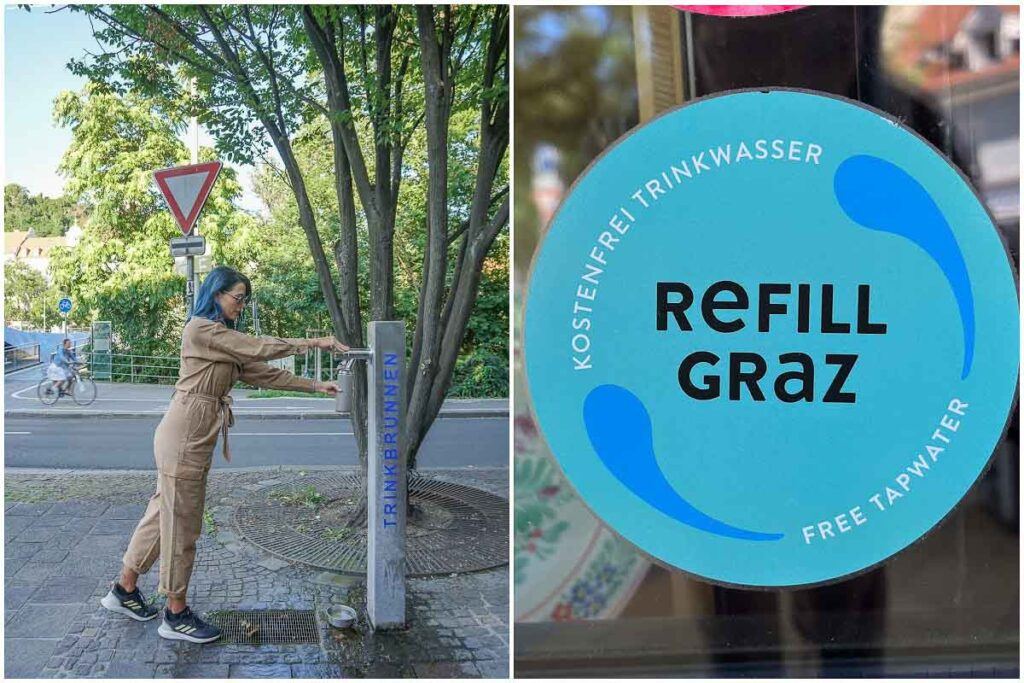
Hydration can come in different forms such as espresso tonic, tea, chilled white wine or a cold beer.
The rule is simple, search for local brands on the menu, Graz, Styrian or Austrian-produced beverages. Or ask the waiter/bartender, they probably know a local drink and can even explain what you are about to taste.
Consuming local products is not only sustainable, but it’s also an opportunity to be open to new flavors, taste unique things and try what the destination does the best. You can do it in Graz and anywhere else.
Feed your body the Graz way
The waiter greeted us with a big smile, I think she remembered us from the previous night. I believe it’s a good compliment to the restaurant when customers come two days in a row.
We sat at the same table and Rob ordered the same dish: pea pure with grilled mushrooms. In his words: “The mix of savory and sweet, the creamy texture of the pure, and smoked flavor from the mushroom was to die for. I need to eat it again.” Got it!
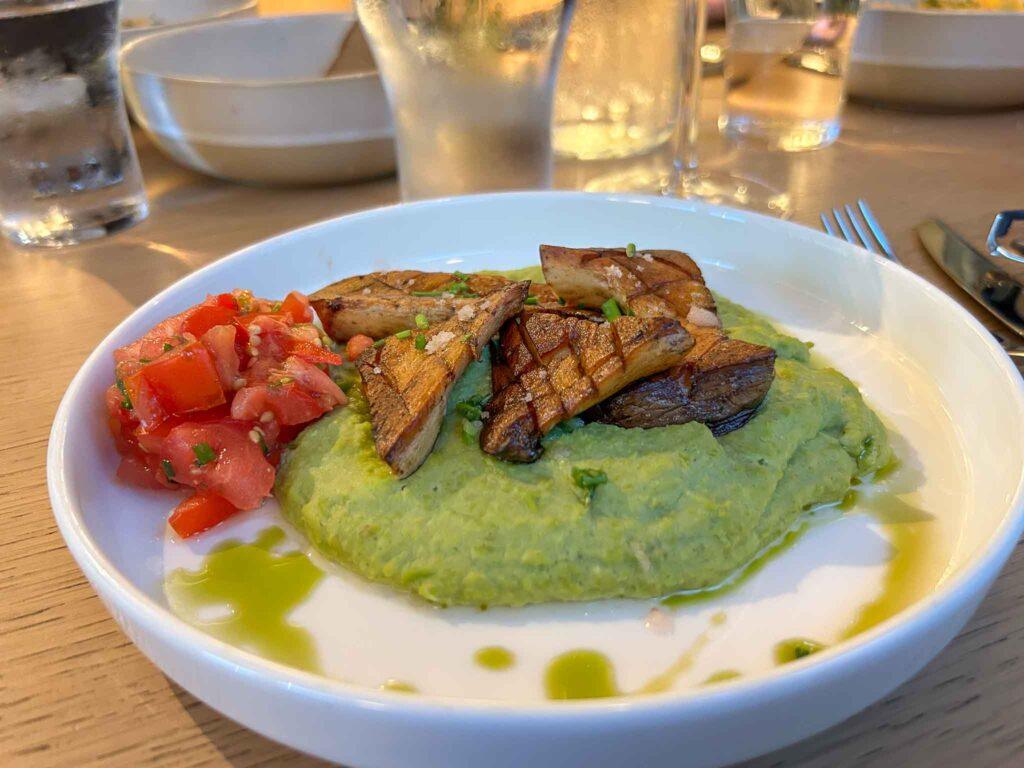
Die Speis is a vegetarian restaurant that focuses on local products. Most of the ingredients come from producers located less than 50 km away. It’s fresh, seasonal and delicious.
The three chefs who run the business take sustainability seriously, from choosing ingredients to preparing the food and pursuing a zero-waste kitchen.
Eating the Graz way is when you opt for restaurants and cafes that focus on local products, vegan/vegetarian menus, zero waste or social projects. An interesting fact is that it’s easy to find these types of restaurants in Graz, they are part of the local food scene.
After our vegan dinner, we passed by a lovely garden with tables by the Mur River, between the Kunsthaus and the Murinsel. The next day we decided to try it out, and without booking in advance, we walked to Hummel.
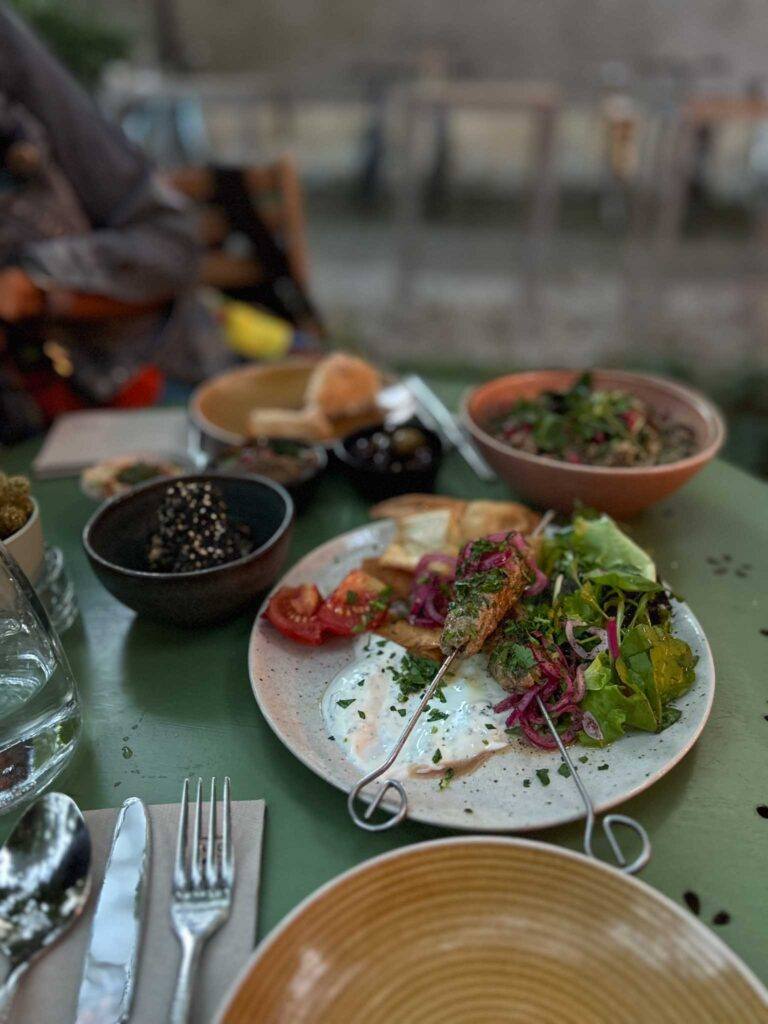
Hummel serves Levante food, middle eastern cuisine cooked with local ingredients, or from small to medium-sized producers. Its mission is to cook delicious food in a sustainable way. And oh boy, we didn’t waste a crumb of it.
We went for the Mezze Table Classic, a potluck of small dishes packed with flavors, served with freshly baked bread, lamb skewer and Styrian wine. The dinner ticked all the boxes!
Graz is called the City of Culinary Delights for a reason, so take advantage of it and try delicious food in a conscious way.
You should also read: What to do in Graz that will ignite your senses
Go conscious shopping in Graz
Lend is a paradise for shopping. It might not have all international brands and fast fashion options, but it does have a handful of small local shops selling well-curated goods and sustainable products.
I already mentioned two places for shopping in Graz, Kwirl Design Shop and Managerie, and near them you will find more options for sustainable fashion, recycling and upcycling goods.
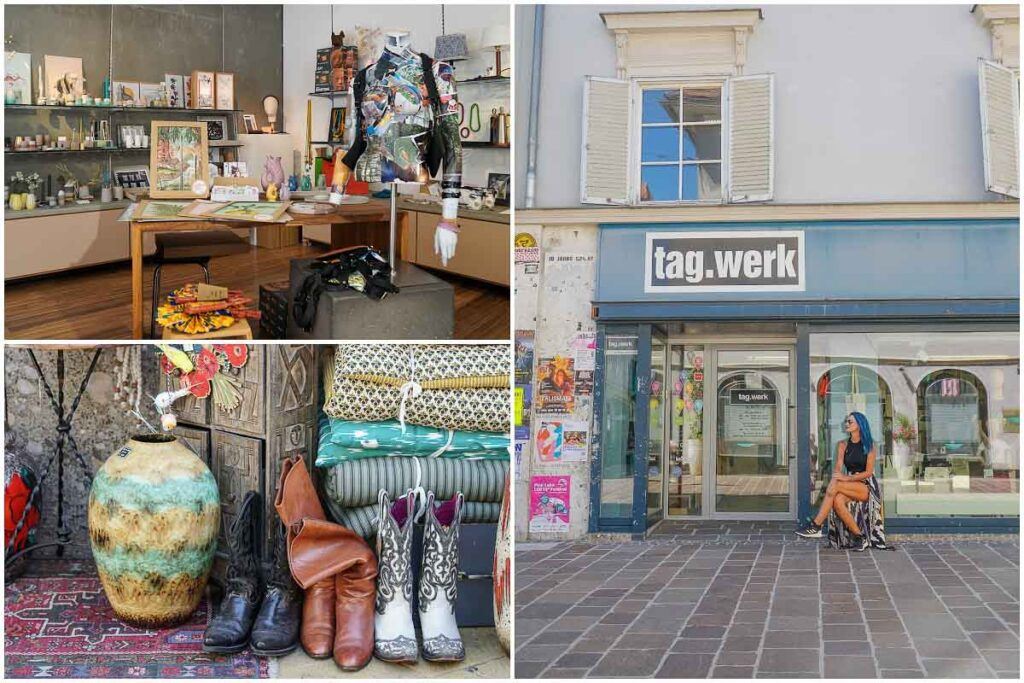
Tag.werk is a place that sells super cool bags and accessories produced by socially disadvantaged young people who are facing difficult life situations.
Heidenspass is another option, they produce and sell upcycled designs from used materials and they employ young people.
Just walk around Lend and Gries and you will find many second-hand shops and interesting places doing good things, from clothes to food and decoration.
How?
Easy, go to S’Fachl and get a handmade or unique product made in the Styria region. It’s a world of food, things for your house, personal items and gifts crafted by small producers or artists. Any purchase goes directly to the community — and that’s sustainable shopping and traveling.
You can buy the Clock Tower magnets at the Graz Tourist Information Center, just below the Styrian Armoury Museum (a must-see). The souvenirs you find there are mostly produced in Austria by local artists.
And don’t forget the bottle of pumpkin seed oil! We already got ours.

Get a new hairdo in a special place
Maria told me so many things about the Lend area, and one of the most interesting facts was about the shop next door.
She introduced me to Jakob, the person behind one of the coolest hair salons I’ve been to. FYI, my mom was a hairdresser, we owned a hair salon, so I know what I’m talking about.
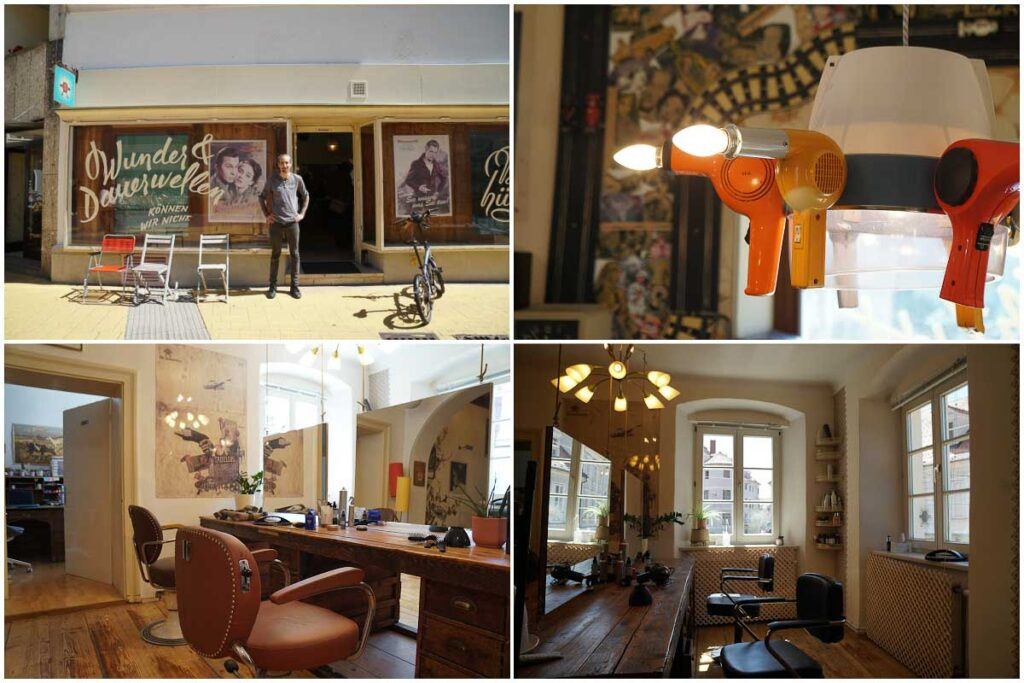
Everything in this place is recycled, upcycled and stylish. The decor is beautiful, the counter is from 1910 and the mirrors are vintage. The only thing new are the scissors.
Die Haarschneidere opened in 2017 and today the team has 15 people from seven different nationalities.
Whether it’s a shop, a hair salon, a restaurant, a cafe or a bar — we should support local businesses that are working for their community. Everybody wins.
Have an experience in nature
It’s easy to be in nature when visiting Graz, 60% of the city is dedicated to urban green spaces and there are plenty of greenscapes around, one of them being Schöckl Mountain.
This beautiful mountain is Graz’s green playground, perfect for those who want to exercise, relax, be in nature, eat and have fun.
Our friend from Graz knows we like a good hike, and this time she took us on a morning adventure to Schöckl.
We followed the Schöneben – Stubenberghaus Trail, which started just beside the cable car station. It was a well-marked, easy trail with a steady ascent among beautiful trees. We were talking, snapping photos and in two hours we reached the summit at 1,445 meters.

The views are gorgeous, and so is the food.
The restaurant serves delicious local dishes. We got beef soup with cheese dumplings and Rob ordered pork chops, along with beer and a white spritz for hydration. Cheers!
We were so lucky with the weather, it was beautiful and sunny, so different from our last hike in Graz (check it out here).
What I love about Schöckl is that you can hike, mountain bike, trail run and paraglide there. When you are tired, you go back down with the cable car, or for a thrilling experience, ride the Hexenexpress.
You can enjoy Schöckl Mountain even if you are not into sports. Get the bus from Graz to Schöckl Cableway lower station, from there get the cable car up, have a nice meal, meet people and then come down. Easy and accessible.
Being in nature, hiking and cycling are good for your body and mind, and they are low-carbon activities, which means good for the world too.
Sleep well in Graz
Remember I mentioned that our hotel was very interesting? So, LendHotel got on our radar as a suggestion for a locally owned property, a unique hotel that has a sustainable and artistic touch.

We loved it. The hotel looks like a modern art gallery, there are paintings and sculptures everywhere, mostly from Austrian artists. The decor is clean and funky, and the staff is young and lovely.
There is a small gym and a rooftop bar. Breakfast is a feast that comes from the organic local market, and the rooms are bright and comfy.
The hotel was such a great surprise that I might write a review about it. Should I?
Now let me ask you one thing, how do you choose and book your accommodation? Have you ever thought that your stay can have a positive impact on the destination?
I’m not talking about using towels and bedsheets for more than a day.
To be honest, before Graz, I didn’t think much about this, especially with accommodation prices going through the roof during the European summer.
But if I want to be a conscious traveler, I can’t ignore the fact that my choice of hotel has an impact, so let’s try to do it right.
From now on, let’s try to book rooms at family-owned hotels, small properties or guesthouses. Homestays and hostels are also good options.
Another possibility is to look for accommodations that are eco-friendly, serve locally sourced food or have a social project going on. Check their website and social media, and do your due diligence.
Here is a list of the family-owned hotels in Graz to inspire you.
Plan how to get around Graz mindfully
This isn’t so much about what to do in Graz, but how to get around.
There is no need for a car to visit Graz. Almost everything is within 20 minutes walking distance. And if it’s high, like the Clock Tower, you can always rely on the elevator or funicular.
In case you want to explore further, like going to Schloss Eggenberg Palace, to Schöckl Mountain, or to/from the airport, you can do so with public transportation. Trams and hydrogen-powered buses run throughout the city, making the locals and tourists’ lives easy.
Don’t forget to get your Graz Card, it will give you access to almost all attractions and museums, plus free transportation within zone 101, which includes the airport and places we mentioned in the guide.
If you like cycling, Graz has many bike lanes. You can rent bikes at shops and hotels (extra points for LendHotel, they have bikes for guests).

One of our favorite cycling paths is by the Mur River, check it out. For more cycling routes, talk to Eva from the CoffeeRide. She is a biker and can share great tips over a cup of coffee and cake.
Getting to Graz is easy. The city is well connected, you can fly, take a bus or train.
Flying is usually the least eco-friendly transport, though in some cases it’s the only option. Nowadays, some airlines are displaying the estimated carbon footprint of the flight and offering options to offset it.
As an alternative to flights, consider trains and buses for long journeys. Public transportation, ride-sharing, cycling and walking in the cities are the responsible way to go.
Travel Advice:
Don’t forget your Travel Insurance! You don’t want anything to ruin your trip, right? So don’t take the risk! Reliable travel insurance can help you in case of travel issues, from accidents to health problems, travel delays, and lost luggage.
There are many insurances in the market, our picks are HeyMondo and SafetyWing. We used both and always had a good experience. Click on the insurance names to get a quote.
Graz as a Sustainable City
You might not know, but Graz is not only an incredible city with UNESCO Heritage Sites, it was the European Capital of Culture in 2003 and was named City of Design and City of Culinary Delights. Plus, it’s focusing on sustainable holidays.
Graz has an impressive past and big promises for the future, as 20% of its population are students who bring innovation, design thinking and a lively atmosphere to the city.
For me, Graz is a city where the past and modern converge, a place where you arrive as a tourist and leave feeling like a local.
And that’s how I finished this trip, feeling like I belonged to Graz and telling you to visit it as soon as possible.
As of now, look for similar indicators (or sustainable signs) when choosing your next destination after Graz. I’m sure you will find incredible places waiting to be experienced by a conscious traveler.
PS: While I’m writing this sustainable guide to Graz, the city is waiting for an important nomination. It’s competing for the European Green Capital Award 2025 alongside Brasov in Romania; Brescia, Cagliari and Novara in Italy; Guimarães in Portugal, Logroño in Spain, Poznań and Rzeszow in Poland; and Vilnius in Lithuania. Good Luck Graz!
Do you love this sustainable travel tips? Pin them for later!
